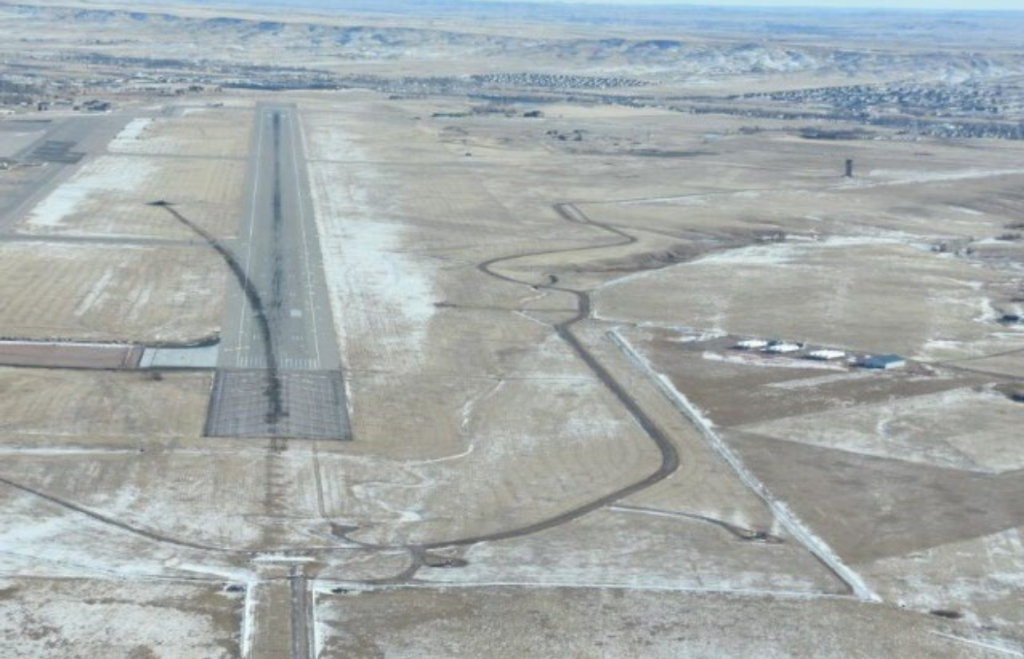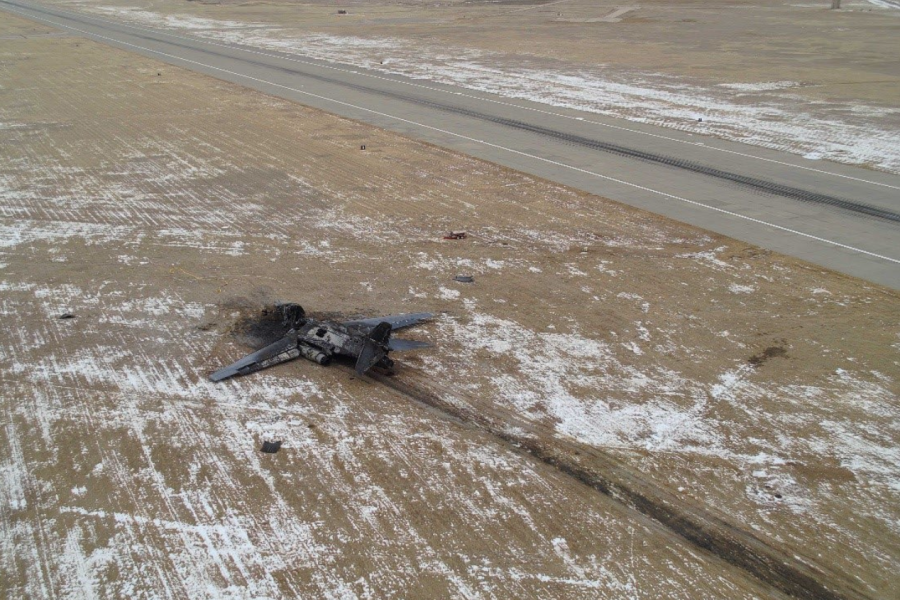A high-profile crash of a B-1B Lancer at Ellsworth Air Force Base, S.D., earlier this year destroyed the $450 million bomber and was caused by a cascading series of aircrew missteps, overlooked information, and an overall lax culture in units at the base, according to an Air Force accident investigation report released July 25.
Taken together, the series of mistakes turned a landing in poor weather into a crash when the B-1 slammed into the ground 100 feet short of the tarmac, slid to a stop, and caught fire, the Accident Investigation Board report concluded. The four aircrew ejected and survived, but two suffered injuries, and the aircraft itself largely disintegrated.
Investigators primarily cited aircrew errors as the bomber approached Ellsworth Air Force Base’s lone runway in poor weather on Jan. 4, 2024, as the main cause of the mishap. But they also found many mistakes in the hours and even months leading up to those fateful seconds and issues with the unit and base personnel that contributed to the crash.
“This investigation has shown that many failures leading to this mishap were not a one-time occurrence or an aberration,” the report stated, detailing over two dozen human error infractions. While the crash would not have happened in good weather, the board was blistering in its criticism of the aircrew, support personnel, and their leaders.
The report cited numerous contributing factors to the crash, including “poor crew resource management, poor weather conditions, ineffective flight operations supervision, a lack of awareness of airfield conditions, and an organizational culture that tolerated decaying airmanship skills, a lack of discipline, poor communication, and inadequate focus on regulations.”
“The chain of command is in the process of responding to the report and taking the appropriate corrective actions,” Air Force Global Strike Command said in a statement.
The aircraft was part of a two-ship of B-1s on a training mission, callsigns FELON 01 and FELON 02. Due to minor maintenance issues, which the Air Force said did not contribute to the crash, the mishap aircraft, FELON 02, took off two hours after the lead aircraft. The weather began deteriorating during the training sortie, and the crews considered diverting to Tinker Air Force Base, Okla., but they decided to proceed back to their home base despite the changing weather conditions.
The first aircraft, FELON 01, landed without incident on Runway 13 at the base. But when the second aircraft encountered wind shear, the pilot mismanaged the throttles, allowing the plane to become too slow and too low. By the time the crew realized the error in the dense fog, the plane was sinking too fast and hit the ground.
“The mishap aircraft continued to skid onto Runway 13 for approximately 5,000 feet and toward the left, eventually coming to a rest in the infield between two of the airfield’s taxiways. The [aircraft] caught fire during the mishap sequence and was a total loss. The total estimated loss from the mishap is $456,248,485.00,” the report detailed.

An Air Force official told Air & Space Forces Magazine that the service has not yet decided whether to regenerate another B-1 from storage. Two of 17 aircraft placed in long-term storage at Davis-Monthan Air Force Base by the 309th Aerospace Maintenance and Regeneration Group—known as the Boneyard—were recently regenerated.
While the bad weather was a factor in the crash, prohibitions in a Notice to Airmen (NOTAM), against landing in the conditions the flight faced were not followed.
“FELON flight aircrews discussed the required visibility for the approach collectively,” the report stated. “They erroneously agreed that a visibility-only straight-in approach to Rwy 13 required only a minimum visibility of 1/2 [mile], contrary to the 3/4 [mile] minimum stated in active NOTAM.”
The reason for that mistake was clear, the investigation found. The NOTAM, which increased the required increased visibility to land on the runway roughly two weeks before the crash, was not contained in the pre-flight briefing.
“This NOTAM was not explicitly highlighted,” the report stated, though higher-ups were aware of its existence and some dismissed its importance.
Investigators also said the Airmen failed to properly follow what is known as crew resource management and cross-check their instruments.
“Changes in local wind direction during landing should have prompted the crew to adjust throttles and maintain proper airspeed, but a lack of situational awareness and ineffective crew communication resulted in the aircraft falling below required airspeed to maintain a safe approach,” AFGSC said in a release.
While wind shear incidents can be dangerous, there are many common aircraft safety procedures in place that were not followed during FELON 02’s flight. Practices such as crew resource management and maintaining proper situations awareness are usually drilled into all pilots to reduce mistakes.
“Throughout its investigation, the Accident Investigation Board found unsatisfactory levels of basic airmanship, an inadequate focus on foundational governing directive knowledge, and an overall lack of discipline throughout the 34 [Bomb Squadron],” the report concluded. “The preponderance of the evidence revealed an ineffective and unhealthy culture, which directly contributed to the mishap.”
The report also faulted the 28th Operational Support Squadron, which manages the base, for its briefing failures, weather reports, and other confusion. The crew only received weather for Runway 31, not Runway 13, which has an approach in the opposite direction on the same strip of tarmac. Runway 13 had an issue with a visibility sensor, a known issue, compounding Airmen’s mistakes.
Ultimately, the board found the lack of a cross-check directly caused the crash because the pilots lost control of what to do and when.
But the report made clear investigators thought FELON 02 should never have tried to land on the runway in such poor visibility and without full knowledge of their surroundings—and many people were to blame.
“I have noted that the mishap occurred due to numerous factors, including a culture of noncompliance, widespread deviation from established policy and procedure, and several organizational influences and preconditions,” Col. Erick D. Lord, the president of the AIB, wrote.
The full report is available online here.
